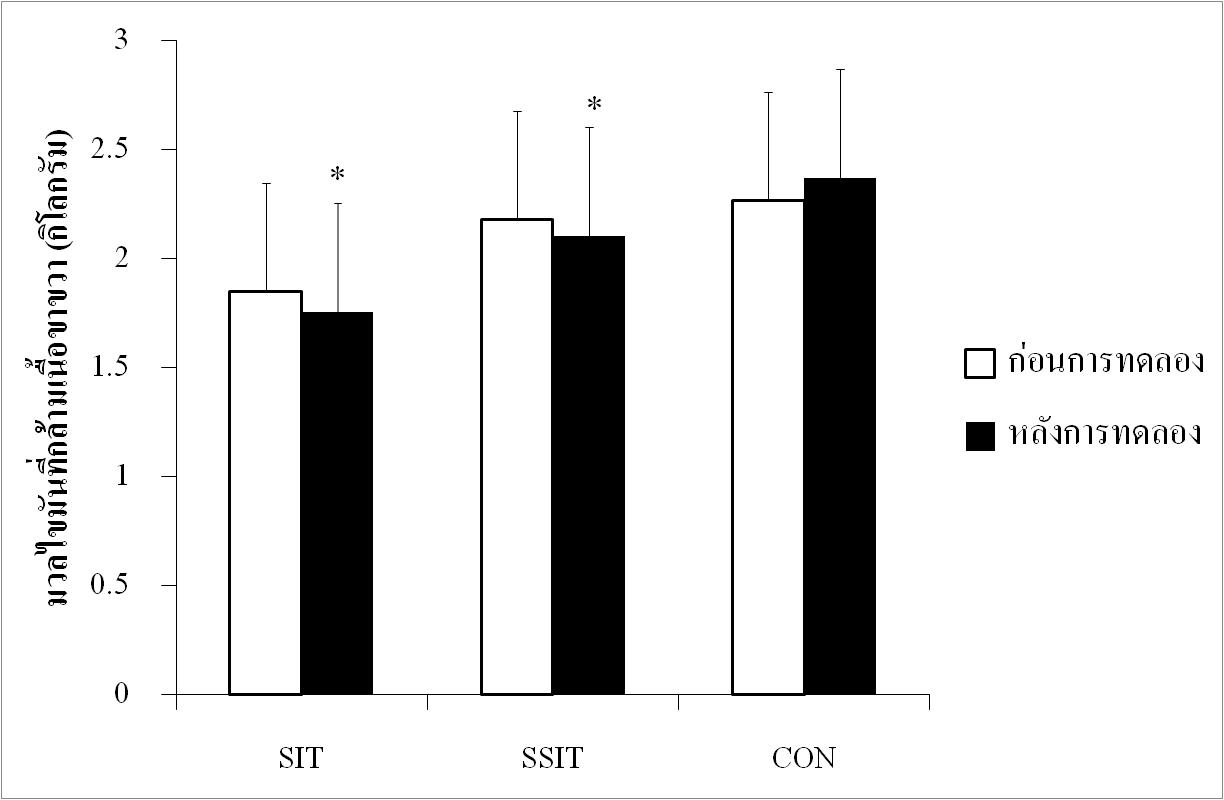THE EFFECTS OF SUPRAMAXIMAL HIGH-INTENSITY INTERMITTENT TRAINING ON FAT MASS AND LEAN MASS IN YOUNG MALE ATHLETES
Main Article Content
Abstract
Purpose The purpose of this research was to study and compare the effect of supramaximal high-intensity intermittent training (SIT) and specific-sports supramaximal high-intensity intermittent training (SSIT) on fat mass and lean mass in young athletes.
Methods Forty-five young male athletes were randomly allocated to control (CON), SIT, and SSIT groups. The SIT program consisted of 10 sets of 30 s of cycle ergometry at 170 % of VO2 max alternated with 30 s of resting periods. The SSIT program consisted of 10 training postures of 30 s alternated with 30 s of resting periods . Both programs were designed to yield the same energy expenditure and training session. The SIT and the SSIT underwent training program 3 times per week for 10 weeks. The control group (CON) was a group of athletes who did not receive any additional training programs. Dual-energy x-ray absorptiometry was used to measure fat mass and lean mass as compare to pre-post test.
Results Mean values of leg fat mass were siginificantly decrease (P<0.05) in both SIT and SSIT as compared to pre-test and CON group, and Mean values of leg lean mass were significantly increased (P<0.05) in both SIT and SSIT as compared to pre-test and CON group. There were no differences between three groups (SIT, SSIT, and CON) in mean values of fat mass and lean mass at trunk and arms pre-and post-test.
Conclusion Both SIT and SSIT programs have a similar effect on increasing of leg lean mass and decreasing of leg fat mass.
Article Details
References
Anek, A., Kanungsukasem, V., Bunyaratavej, N. (2011). Effects of the circuit box jumping on bone
resorption, health- related physical fitness and balance in premenopausal women. Journal of Medical Association of Thailand.94: s17-s23
Boutcher, S. H. (2011). High-intensity intermittent exercise and fat loss. Journal of Obesity, 868305.
Bravo, D. F., Impellizzeri, F. M., Rampinini, E., Castagna, C., Bishop, D., & Wisloff , U. (2008). Sprint vs. interval training in football. International Journal of Sports Medicine, 29(8), 668–674.
Chuensiri, N., Tanaka, H., & Suksom, D. (2015). The acute effects of supramaximal high-intensity intermittent exercise on vascular function in lean vs. obese prepubescent boys. Pediatric Exercise Science, 27, 503–509.
Earnest, C. P. ( 2008). Exercise interval training: An improved stimulus for improving the physiology of pre-diabetes. Medical Hypotheses, 71, 752–761.
Foster, C. (1998). Monitoring training in athletes with reference to overtraining syndrome. Medicine & Science in Sports & Exercise, 30(7), 1164–1168.
Inoue, A., Impellizzeri, F. M., Pires, F. O., Pompeu, F. A., Deslandes, A. C., & Santos,T. M. (2016). Effects of sprint versus high-intensity aerobic interval training on cross-country mountain biking performance: A randomized controlled Trial. Plos One, 11(1), e0145298.
Krabuanrat, C. (2014). Science of Coaching. Bangkok: Sintana Book.
Keating, S. E., Machan, E. A., O'Connor, H. T., Gerofi, J. A., Sainsbury, A., Caterson, I.D., & Johnson, N. A. (2014). Continuous exercise but not high intensity interval training improves fat distribution in overweight adults. Journal of Obesity, 2014, 834865.
McArdle, W. D., Katch, F. I., & Katch, V. L. (2000). Essensials of exercise physiology. United States of America: Lippincott William&Wilkins.
Maillard, F., Rousset, S., Pereira, B., Traore, A., de Pradel Del Amaze, P., Boirie, Y., Duclos, M., & Boisseau, N. (2015). High-intensity interval training reduces abdominal fat mass in postmenopausal women with type 2 diabetes. Diabetes & Metabolism, 42(6), 433–441.
Mitranun, W., Deerochanawong, C., Tanaka, H., Suksom, D. (2014). Continuous vs interval training on glycemic control and macro- and microvascular reactivity in type 2 diabetic Patients. Scandinavian Journal of Medicine & Science in Sports, 24(2), e69-e76.
Tabata, K., Nishimura, M., Kouzaki, M., Hirai, Y., Ogita, F., Miyachi, M., & Yamamoto, K..(1996). Effects of moderate-intensity endurance and high-intensity intermittent training on anaerobic capacity and vo2 max. Medicine and Science in Sports and Exercise, 28(10), 1327–1330.
Talanian, J.L. (2007). Two weeks of high – intensity aerobic interval training increases the capacity for fatty oxidation during exercise in women, Journal of applied physiology , 102, 1439-1447.
Tjonna, A.E., Lee, S. J., Rognmo, O., Stølen, T. O., Bye, A., Haram, P. M., Loennechen, J. P., AI-Share , Q. Y., Skogvoll, E., SlørdahlS, A., Kemi, O. J., Najjar, S. M., & Wisløff, U. (2008). Aerobic interval training versus continuous moderate exercise as a treatment for the metabolic syndrome a pilot study. Circulation, 118, 346–354.
Trapp, E. G., Chisholm, D. J., Freund, J., & Boutcher, S. (2008). The effects of high-intensity intermittent exercise training on fat loss and fasting insulin levels of young women. International Journal Obesity, 32, 684–91.
Tremblay, A., Despres, J. P., Leblanc, C., Craig, C.L., Ferris, B., Stephens, T., & Bouchard, C. (1994). Effect of intensity of physical activity on body fatness and fat distribution. The American Journal of Clinical Nutrition, 51(2), 153–1577.
Zhang, H., Tong, K. T., Qiu, W., Wang, J., Nie, J., & He, Y. (2015). Effect of high-intensity interval training protocol on abdominal fat reduction in overweight chinese women: a randomized controlled trial. Kinesiology, 47(1), 57–66.


